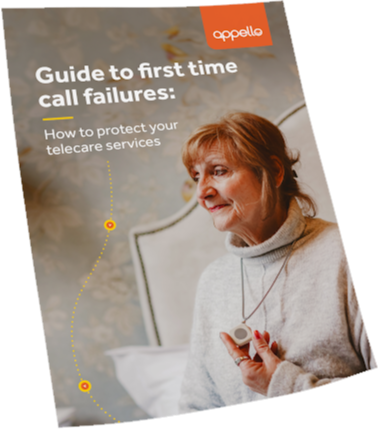There’s a lot of information about digital telecare for housing providers to digest. This can include mixed messages from various sources in the telecare industry, as well as misunderstandings of the timings and impact of the digital upgrade to our telecoms network.
As a result, you may be unsure about certain elements of digital telecare or what timeframe you need to be working to when considering your upgrade to digital technology.
In this blog post, we shed light on some of the common misconceptions we hear from housing providers.
1. The digital switch is happening in 2027
2. There’s still plenty of time to plan our upgrade to digital telecare
3. Telecoms providers will organise our move to digital
4. Suppliers will organise our move to digital
5. We can use an analogue adapter to convert existing equipment to digital
6. The cybersecurity risks of digital make this difficult to implement
7. Moving to digital telecare is costly
8. Our customers don’t want change and will resist digital telecare
9. Digital telecare is not yet proven
10. Our customers have concerns about this technology in their homes
Misconception 1: The digital switch is happening in 2027
When the telecoms industry announced the UK’s move to a digital network, 2025 was given as an end date for the upgrades, this has now been extended to 2027 by Openreach. However, this is not a national ‘switch on’ date, the point when the transition from analogue to digital will happen. Rather, 2027 indicates when the analogue network will be turned off. The digital rollout has actually been underway for some time now. Many areas are already on the digital network – and we can see this is already impacting telecare services. It is therefore important to recognise that upgrading to digital equipment should be done prior to your property or region being migrated to the digital telecoms network. This will ensure that your telecare services are not impacted once these changes occur.
Misconception 2: There’s still plenty of time to plan our upgrade to digital telecare
Putting aside the fact the digital switchover is in progress (and therefore already risking the reliability of certain analogue telecare services), there are several other reasons why it’s not wise to delay your digital telecare project.
As we highlighted in our digital telecare briefing in autumn 2022, the demand for digital will inevitably increase as we get closer to the publicised 2027 analogue cut-off date. This could lead to supply chain issues, which will delay projects, reduce choice and push up costs. It’s therefore advisable to prioritise the move to digital telecare and get ahead of what could be a very long queue as organisations realise the need to act.
Misconception 3: Telecoms providers will organise our move to digital
Telecare services aren’t operated by the telecoms industry and it’s not up to telecoms providers to ensure telecare services will continue to work after the digital switchover.
The telecoms industry has a responsibility to communicate the plans and timeframes, with information on how this may impact certain services. Openreach has provided a number of industry factsheets and many telecoms providers have opened testing labs to support telecare suppliers.
Arguably, the telecoms industry needs to improve communication to ensure there is no confusion, as highlighted in the Department of Health & Social Care Telecare Stakeholders Action Plan. But it’s not their responsibility to take care of the logistics of individual telecare projects.
Misconception 4. Our supplier(s) will organise our move to digital
As with telecoms providers, suppliers’ responsibilities only extend so far. Suppliers should ensure fully digital telecare solutions are available for their customers and communicate the impact of the digital switchover. But the onus is on housing providers to make sure their telecare services are fit for purpose and will operate correctly over the digital network.
Misconception 5: We can use an analogue adapter to convert existing equipment to digital
This is a key issue – and the cause of some uncertainty for housing providers. As highlighted in recent research, the question of whether an analogue convertor is an adequate solution is “fundamental to many organisations’ definition of what it means to offer a digital telecare service and their view on their level of preparedness for the digital shift”.
The answer is not completely straightforward.
On the face of it, yes, there are adapter devices that can convert an analogue signal so this will be recognised by the digital network.
But it’s important to understand how these can and can’t be used.
An analogue adapter or converter should only be considered a short term solution, due to a number of limitations and potential issues including:
- There is still a risk the analogue signal can be corrupted (with this risk varying depending on how the signal is converted). In addition, analogue convertor solutions often require mains power, so it’s vital contingency measures are in place to cover loss of power.
- Analogue converters must be properly tested: as independent testing by the TSA shows, there is a huge variation in the reliability of analogue telecare equipment over a digital network, due to a whole host of factors. All solutions should therefore be tested to confirm they are fit for purpose.
- Converters are essentially sticking plasters, a temporary solution to bridge a gap. Organisations using these will not get the wider benefits of digital telecare, putting themselves at a competitive disadvantage.
- Analogue equipment will soon be unsupported and effectively obsolete, so housing providers will find they’re ultimately spending more money maintaining an outdated service.
The best option is a fully digital telecare solution. Housing providers need to be aware that analogue converters will not meet their long-term needs and they will still need a plan to move to digital technology.
Misconception 6: The cybersecurity risks of digital make this difficult to implement
Digital telecare involves the transfer of certain data, so this does pose a cybersecurity risk, depending on how this is handled. But this is a risk that can be mitigated, in the same way this is necessary for all IT systems within modern organisations. The flip side, of course, is that digital technology allows you to deliver joined-up and improved services for your customers.
Misconception 7: Moving to digital telecare is difficult and costly
Your digital telecare project will require a cost outlay. But, while this is necessary from a safety perspective, it’s also an investment in your services, allowing you to deliver a range of benefits for both your customers and your organisation. As the Local Government Association advises, some of these benefits will “reduce the costs of running the service; more significant gains can be made by preventing, reducing or delaying the costs of care delivery.” It’s also worth noting that there will be costs associated with maintaining an outdated system, but this will offer none of the advantages of digital.
Misconception 8: Our customers don’t want change and will resist digital telecare
It’s important not to stereotype a diverse group of people. Some older adults may be slower to adopt new technology but we’re all becoming much more used to using online services in our daily lives. As a result, customers’ needs and demands are changing. People will expect the same access and standards from supported housing.
Misconception 9: Digital telecare is not yet proven
Digital technology is now very much tried and tested, in fact Appello have already received over 2 million digital calls! There are many different examples of digital telecare being used within organisations both large and small. This means housing providers yet to make the move can learn from the experiences of those who have already made the transition.
Misconception 10: Our customers have concerns about this technology in their homes
It’s important to communicate with your customers about all aspects of digital telecare and reassure them about what it can and can’t do.
Customer concerns could include:
- Any cameras in our homes risk ‘big brother’ watching – the reality is that cameras are for specific purposes and do not film inside people’s homes.
- Digital telecare equipment will interfere with current equipment – there is no evidence that this could be the case, with huge numbers of people using digital telecare with no issues.
- Digital telecare equipment creates radiation – again, there is no evidence for this. Ensuring your equipment meets British safety standards can reassure your customers the technology is safe to have in their homes.
- Digital telecare equipment will use my electricity or Wi-Fi – while this does operate over the broadband network, this doesn’t affect customers’ existing internet service and any costs are covered by the overall service.
It’s a good idea to tackle potential barriers to embracing digital telecare head-on. Clear communication will help answer any questions, avoid misconceptions and provide reassurance to your customers. This should form a key part of your digital telecare plans – take a look at our guide to engaging your customers with digital telecare for tips on getting started.
Conclusion – the reality of digital telecare
It can be difficult to separate the facts from misinformation regarding digital telecare. The reality is this is the future for these essential services and the advice from independent sources, including the government, is that housing providers need to be prepared for this.
Understanding what digital telecare means and how you can use this to improve your services is an important starting point.
We’ve put together a number of resources to help you on your digital journey, including:
– Your Guide to the Digital Switchover – and how this could be impacting your telecare services
– Managing the Transition to Digital Telecare: How to Plan and Procure the Right Digital Solution
You can find more details on the issue of first time call failures in our latest guide, which is available to download now

Talk to us to discuss your requirements and find out about our cost-effective and future proof digital solutions.



